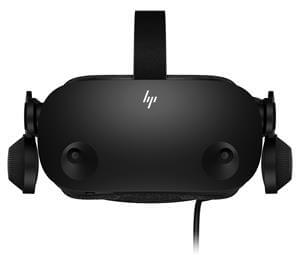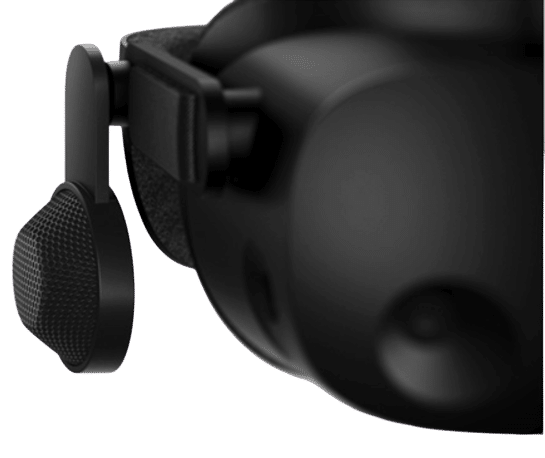The HP Reverb G1 is a very good headset with a few major display flaws which turned customers off. The new announcement for the G2 promises to fix those and bring even more improvements. In this guide, we will explain each headset and show you the differences in the HP Reverb G1 vs G2.
This will help you decide whether to buy the HP Reverb over other popular headsets from Oculus or HTC.
Let’s get started.
Other VR headset comparisons to check out (links will open in a new window):
What is the HP Reverb?

The HP Reverb is a VR Headset built on the Windows Mixed Reality (WMR) platform. WMR is an ecosystem from Microsoft designed for head-mounted displays. Other devices on the WMR platform include the Microsoft HoloLens AR glasses and the Samsung Odyssey+ and Acer OJO 500 VR headsets.
WMR devices integrate well with the Windows 10 platform, promising low latency and high performance with a connected PC. You can also stream and use Windows 10 on your WMR VR headset.
All WMR devices also support the Steam platform for a wider selection of games.
Check out our VR Headset Comparison Tool for a table of of specs for all headsets.
Where to Buy
HP Reverb G2
When HP announced the Reverb G2 VR headset, they immediately placed a preorder link for the hardware on their website. The G2 is expected to launch in the fall of 2020.
Click here to buy the HP Reverb G2 from the officlal website.
HP Reverb G1
Buy the Reverb G1 from Amazon or the official website below.
No products found.
Click here to buy the HP Reverb G1 from the official website.
HP Reverb G1 vs G2 Price
Both the HP Reverb G1 and G2 both retail for $599 USD. This is more than Oculus’ VR headsets which retail for $399, but less than the average price of an HTC Vive headset.
We would expect to see discounts on the G1 as soon as the new model is officially released. However, it appears that HP has low stock on the G1 anyways, so you might only be able to buy the G1 second-hand soon.
Since the Reverb G2 has better specs, it is worth it to find the newer model. We’ll explain more below in our Specs area for each VR headset.
HP Reverb G1 vs G2 Release Dates
The original HP Reverb G1 was released on April 26, 2019.
The new HP Reverb G2 was announced in a May 28, 2020, announcement. On the same day, HP announced that the device was available for preorder. The official release date was originally set for September 15th, 2020, but an email was released to suppliers on September 2nd that stated:
We would like to inform you about the status of your HP Reverb G2 pre-order.
HP has informed us that the Reverb G2 is currently being equipped with new, improved lenses in the production process. This upgrade will further increase the quality of the product, but according to HP it is accompanied by a slight delay in the initial delivery to all dealers. Based on the new availability date communicated to us by HP, we expect your order to be shipped by the end of October.
You can preorder the G2 today from the official HP website. A leaked report from the online European retailer Schenker indicates that the price might increase from $599 up to $699 in the near future. If this rumor is true, then you’ll want to get your headset now.
The G1 vs G2 has some specific similarities and differences, which we will discuss below!
HP Reverb G1 vs G2 Summary

The overall summary of the HP Reverb G1 and G2 are the same. It is a PC VR headset that must be tethered to a connected gaming PC. The PC requirements for the Reverb G1 and G2 headsets are the same:
- Nvidia GeForce GTX 1080 (or Nvidia Quadro P5200 / AMD Radeon Pro WX 8200) or better. Consider the new Nvidia GeForce RTX 30-series since the 3070 provide excellent value!
- Intel Core i7
- 16 GB of RAM.
The Reverb features a series of outward-facing cameras that allow six-degrees-of-freedom (6DOF) movement tracking. This tracking is done without using external sensors called base stations that need to be placed around you. The Reverb connects to PCs over a mini DisplayPort connection and not HDMI, so some gaming laptops are incompatible.
Below, we dig into more of the specific HP Reverb specifications and differences in the G1 vs G2.
G1 vs G2 Specifications
The table below explains the similarities and differences between each HP Reverb VR headset. Underneath the table we point out some important facts!
| HP Reverb G1 | HP Reverb G2 | |
| Display | LCD RGB | LCD RGB |
| Resolution Per Eye | 2160×2160 | 2160×2160 |
| FOV | 115 | 115 |
| Refresh Rate | 90 | 90 |
| IPD Range | 63mm fixed (software adjustable) | 60 – 68 mm adjustable |
| Tracking | Inside-out | Inside-out |
| Weight | 498g | 550g |
| # of Tracking Cameras | 2 | 4 |
| Controllers | 1st Generation Motion Controllers | 2nd Generation Motion Controllers |
| Price | $599 | $599 |
| Buy Link | Amazon | Official Website |
Resolution and Display

On paper, both Reverb headsets contains dual 2,160 × 2,160 LCD lenses. However, HP promises that a number of deficiencies with the Reverb G1 display have been fixed.
For starters, the contrast and brightness on the G2 is better. This will make each game look sharper and brighter.
HP has also fixed a number of issues and complaints that users had with the G1 headset:
- Decreased mura effect, which is a cloudiness in the display that happens when you move your head.
- Got rid of red smearing, which is a drag of red colors when you move your head.
- Reduced chromatic aberration, which is color separation on the edges of the lenses which create a cloudy effect.
The Reverb G1 already had one of the highest number of pixels per degree of view before. These resolution and display improvements on the Reverb G2 should be awesome.
The Reverb G1 already had one of the highest number of pixels per degree of view before. These resolution and display improvements on the Reverb G2 should be awesome.
Interpupillary Distance (IPD)
Interpupillary Distane is an important factor for virtual reality players. IPD is the distance between your eyes and the mean average for the world is 63.5 mm.
However, different races and genders can have different IPD distances. Therefore, users like to have an adjustable IPD in their VR headset.
The initial G1 had a fixed IPD of 63 mm, with no ability to adjust it to your head shape. The new G2 has a mechanically adjustable IPD between 60 and 68 mm. If you are looking at the HP Reverb G1 vs G2, this adjustable IPD might be the feature you need.
The initial G1 had a fixed IPD of 63 mm, with no ability to adjust it to your head shape. The new G2 has a mechanically adjustable IPD between 60 and 68 mm. If you are looking at the HP Reverb G1 vs G2, this adjustable IPD might be the feature you need.
Head Tracking
The original HP Reverb G1 had two cameras which face outward from your head. They are in charge of keeping track of your location in space and watching for movement in your hands and body.
The new G2 adds two more cameras, so that there are four tracking you. This puts the G2 in line with Oculus VR headsets, which also use 4 for tracking.
Audio Quality

There weren’t many complaints about the original Reverb G1 audio. However, the HP Reverb G2 has off-ear headphones that sit 10 mm off your ear. HP claims they provide spatial audio thanks to artificial intelligence and new signal processing features.
HP worked with Valve to bring over headphones very similar to what the Valve Index has. You can remove the stock headphones and use your own if you want, but the new stock audio solution is really nice. They should be clearer than any Oculus headset.
Cable
The Reverb G2 contains a single-barrel cable that is smaller than the G1. A special single cable plugs into your headset and a USB C 3.0 and DisplayPort plug into your computer at the other end.
The G2 includes a 6 meter (18 feet) cable, which is longer than any other VR headset.
Motion Controllers
The HP Reverb G2 contains brand new motion controllers with the device. These controllers make a number improvements over the G1:
- Improved button layout
- Halo design with sensors for tracking position and motion
- Analog grip button
Neither the G1 or the G2 controllers contain capacitive touch buttons, which allow for improved tracking of finger placement on the controllers. This is a disadvantage over others like the Oculus Touch controllers. However, G1 vs G2 there has still been some nice improvement here.
Other Features

The G2 also comes with a few other improvements:
- Improved controller layout
- Quick-release cable
- Face cushion that is easy to clean
- First release of Microsoft Flight Simulator 2020
- 1 year warranty
Hopefully this gives you a give you a good idea of the Reverb G1 vs G2 specifications.
Final Words: HP Reverb G1 vs G2
Despite only being a year old, improvements in the Reverb G2 headset are enough to put your focus to it and forget the original. The display and resolution upgrades get rid of the mura effects and work better with motion. Upgraded spatial audio headphones are top of the line. The G2 headset still has one of the highest pixel densities out of all VR headsets.
Even better, the HP Reverb G2 has the same price tag as the old model, which is a free upgrade.
So overall, G1 vs G2 it’s not really a comparison. The G2 is the best Windows VR headset and one that is easily worth checking out.
Once again, here is where you can buy the HP Reverb G1 and G2:
What’s your experience the HP Windows VR headsets? Use the comment box below to share your thoughts with us!


